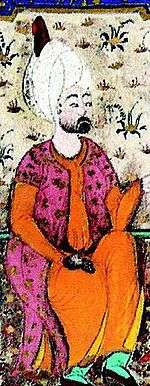Rüstem Pasha
| Damat Rüstem Opuković Pasha | |
|---|---|
 | |
| Grand Vizier of the Ottoman Empire | |
|
In office 28 November 1544 – 6 October 1553 | |
| Monarch | Suleiman I |
| Preceded by | Hadim Suleiman Pasha |
| Succeeded by | Kara Ahmed Pasha |
|
In office 29 September 1555 – 10 July 1561 | |
| Monarch | Suleiman I |
| Preceded by | Kara Ahmed Pasha |
| Succeeded by | Semiz Ali Pasha |
| Personal details | |
| Born |
c. 1500 Skradin, Croatia, Ottoman Empire |
| Died |
10 July 1561 (aged 60–61) Constantinople, Ottoman Empire |
| Nationality | Ottoman |
| Spouse(s) | Mihrimah Sultan (m. 1539–61) |
| Religion | Catholic, converted to Islam |
| Ethnicity | Croat |
Rüstem Pasha Opuković (Turkish pronunciation: [ɾysˈtem paˈʃa]; Ottoman Turkish: رستم پاشا; Serbian: Rustem-Paša Opuković c. 1500 – 10 July 1561) was a Croatian or Serbian-born[1] Ottoman statesman. He served as the grand vizier of sultan Suleiman the Magnificent. Rüstem Pasha is also known as Damat Rüstem Pasha (the epithet damat meaning "son-in-law" to the Ottoman dynasty) because of his marriage to one of the sultan's daughters.
Biography
Of Croatian or Serbian[2] descent, Rüstem Pasha's birthplace was Skradin, a town today located in Croatia. He was taken as a child to Istanbul, where he built a military and bureaucracy career. On 26 November 1539, he married Mihrimah Sultan, the daughter of Suleiman the Magnificent and Hürrem Sultan. Rüstem Pasha held the title Grand Vizier twice, first from 1544–1553 and second from 1555–1561, until his death. As Grand Vizier, he collected vast wealth. He spent a chunk of his wealth raising public buildings, mosques, and charitable foundations. At the time of his death in Constantinople on 10 July 1561, his personal property included 815 lands in Rumelia and Anatolia, 476 mills, 1700 slaves, 2,900 war horses, 1,106 camels, 800 Qur'ans, etc.
The Rüstem Pasha Mosque (Turkish: Rüstem Paşa Camii) is an Ottoman mosque located in Hasırcılar Çarşısı (Strawmat Weavers Market) in Fatih, Turkey,[3] which was designed by Ottoman imperial architect Mimar Sinan for Grand Vizier Rüstem Pasha. It was built between 1561 and 1563.[4]
Children
Together with Mihrimah Sultan, he had three children; one daughter and two sons:
- Ayşe Hümaşah Hanımsultan
- Sultanzade Osman Bey
- Sultanzade Mehmed Bey
Popular culture
In the acclaimed Turkish television series Muhteşem Yüzyıl, he is portrayed by actor Ozan Güven.
See also
References
Footnotes
Bibliography
- Lybyer, Albert Howe (1913). The government of the Ottoman empire in the time of Suleiman the Magnificent. Cambridge, Massachusetts: Harvard University Press. OCLC 1562148.
- Denny, Walter B. (2005). Iznik: The Artistry of Ottoman Ceramics. Thames & Hudson. ISBN 0-500-51192-6.
- Faroqhi, Suraiyah (2005). Subjects of the Sultan: Culture and Daily Life in the Ottoman Empire. I B Tauris. ISBN 1-85043-760-2.
| Political offices | ||
|---|---|---|
| Preceded by Hadım Süleyman Pasha |
Grand Vizier of the Ottoman Empire 28 November 1544 – 6 October 1553 |
Succeeded by Kara Ahmed Pasha |
| Preceded by Kara Ahmed Pasha |
Grand Vizier of the Ottoman Empire 29 September 1555 – 10 July 1561 |
Succeeded by Semiz Ali Pasha |
